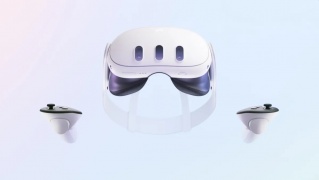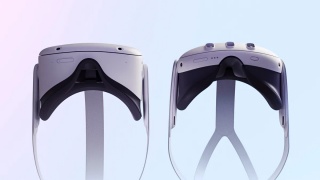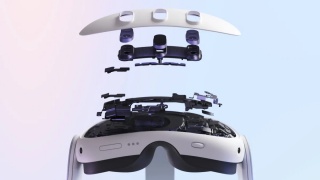Difference between revisions of "Meta Quest 3"
Xinreality (talk | contribs) (→Introduction) |
Xinreality (talk | contribs) |
||
| Line 115: | Line 115: | ||
== Future Coverage == | == Future Coverage == | ||
The review concludes with a note that future coverage will explore the Quest 3's performance as a pure PC VR headset, particularly with features like Quest Link and Air Link. | The review concludes with a note that future coverage will explore the Quest 3's performance as a pure PC VR headset, particularly with features like Quest Link and Air Link. | ||
| + | |||
| + | |||
| + | = Meta Quest 3 Review: An Excellent VR Headset With Barely Passable Mixed Reality = | ||
| + | |||
| + | == Overview == | ||
| + | Meta Quest 3, a significant upgrade from its predecessor, the [[Meta Quest 2]], features a slimmer visor, advanced pancake lenses, a next-generation chipset, color cameras, and a depth sensor. The headset promises an enhanced VR experience and introduces mixed reality capabilities. Despite its higher price compared to the Quest 2, it offers notable improvements in terms of comfort, display quality, and performance. | ||
| + | |||
| + | == Specifications and Comparison == | ||
| + | === General Specs === | ||
| + | The Quest 3 boasts a 40% slimmer visor, innovative pancake lenses, and a new chipset, setting it apart from its predecessors and competitors like the [[Apple Vision Pro]] and [[Pico 4]]. Starting at $500, it is priced higher than the Quest 2 but aims to justify the cost with its enhanced features. | ||
| + | |||
| + | === Comfort and Weight === | ||
| + | The Quest 3 offers a more comfortable user experience with a softer facial interface and a more accommodating design for glasses wearers. Despite being slightly heavier than the Quest 2, its improved design and weight distribution result in a lighter feel on the face. | ||
| + | |||
| + | == Display and Visuals == | ||
| + | === Pancake Lenses and Field of View === | ||
| + | The pancake lenses contribute to a slimmer design and provide sharper, clearer images with minimal need for eye alignment adjustments. The Quest 3 also features a wider field of view than the Quest 2, enhancing the immersion in VR experiences. | ||
| + | |||
| + | === Display Quality === | ||
| + | The displays of the Quest 3 are higher resolution compared to previous Meta headsets, offering graphics comparable to the [[HP Reverb G2]]. However, the use of regular LCDs with no local dimming or quantum dot layer limits its contrast and ability to display true black. | ||
| + | |||
| + | == Mixed Reality Capabilities == | ||
| + | The Quest 3 introduces true color passthrough for mixed reality experiences, a significant improvement over the black and white view of the Quest 2. However, issues like geometric warping, ghosting, and the lack of dynamic occlusion affect the overall mixed reality experience. The headset's automated room scanning for mixed reality enhances practicality compared to manual setup processes of earlier models. | ||
| + | |||
| + | == VR Gaming and Performance == | ||
| + | Equipped with the Snapdragon XR2 Gen 2 chipset, the Quest 3 provides a substantial performance upgrade, allowing for higher resolution gaming and smoother system interface interactions. The improved hardware supports more detailed graphics, moving closer to console-quality in a standalone headset. | ||
| + | |||
| + | == Safety and Boundary System == | ||
| + | The Quest 3 introduces a more intuitive safety boundary system with automated suggestions, although traditional boundaries are still in use. The depth projector aids in setting up more accurate boundaries, enhancing safety and convenience. | ||
| + | |||
| + | == Controllers and Hand Tracking == | ||
| + | The new Touch Plus controllers offer improved ergonomics and tracking, along with enhanced haptic feedback. Hand tracking is also noticeably improved, supporting a wider range of lighting conditions. | ||
| + | |||
Revision as of 03:24, 2 December 2023
| Meta Quest 3 | |
|---|---|
| Basic Info | |
| VR/AR | VR |
| Type | head-mounted display |
| Subtype | Standalone VR |
| Platform | Meta Quest |
| Manufacturer | Meta |
| Announcement Date | June 1, 2023 |
| Release Date | October 10, 2023 |
| Price | $499 |
| Website | meta.com |
| System | |
| Operating System | Android |
| Chipset | Qualcomm Snapdragon XR2 Gen 2 |
| CPU | Octa-core Kryo (1 x 3.19 GHz, 4 x 2.8 GHz, 3 x 2.0 GHz) |
| GPU | Adreno 740 |
| Storage | |
| Storage | 128 GB |
| Memory | 8 GB |
| SD Card Slot | No |
| Display | |
| Display | 2 x LCD |
| Subpixel Layout | RGB stripe |
| Resolution | 2064x2208 |
| Refresh Rate | 120 Hz |
| Image | |
| Horizontal FoV | 110° |
| Vertical FoV | 96° |
| Peak Pixel Density | 25 PPD |
| Optics | |
| Optics | Pancake lenses |
| Ocularity | Binocular |
| IPD Range | 58-71 mm |
| Passthrough | Dual 18 PPD color passthrough cameras |
| Tracking | |
| Tracking | 6 DoF Inside-out via 4 integrated cameras |
| Base Stations | No |
| Eye Tracking | No |
| Face Tracking | No |
| Hand Tracking | Yes |
| Body Tracking | No |
| Audio | |
| Audio | Integrated stereo speakers |
| Microphone | Yes |
| 3.5mm Audio Jack | Yes |
| Connectivity | |
| Ports | USB Type-C, charging contacts |
| Wired Video | USB Type-C |
| Wireless Video | WiFi streaming |
| WiFi | WiFi 6E |
| Bluetooth | Bluetooth |
| Charge Time | 2.3 hours |
| Device | |
| Material | Plastic, foam facial interface |
| Headstrap | Flexible fabric strap |
| Haptics | Yes |
| Color | White |
| Input | 2 x Meta Quest Touch Plus Controllers |
Contents
- 1 Introduction
- 2 Overview
- 3 Software Potential
- 4 Market Position and Recommendation
- 5 Future Coverage
- 6 Meta Quest 3 Review: An Excellent VR Headset With Barely Passable Mixed Reality
Introduction
The Quest 3, the successor to the Quest 2, was released three years later, marking another significant step by Meta in the development of VR hardware. Despite its potential, the full capabilities of the Quest 3 are yet to be fully realized.
Overview
Quest 3 presents itself as a next-generation VR headset, particularly in terms of hardware. Priced at $500, it is a substantial improvement over its predecessor, Quest 2, which was priced at $300. The Quest 3 boasts impressive hardware, comparable to a cheaper version of the Quest Pro, albeit without eye-tracking and face-tracking features. Despite these omissions, Quest 3 remains a favorable choice even if priced similarly to the Quest Pro.
Key Improvements in Hardware
The Quest 3 showcases several advancements in its hardware:
- Lenses: A significant improvement over the Quest 2, offering wider field-of-view and reduced glare.
- Resolution and Clarity: Though not massively higher than Quest 2, the Quest 3 provides improved clarity and a reduction in screen-door effect.
- Ergonomics: Despite minimal ergonomic advancements, the adaptability of the headset for individual users is enhanced.
- Field-of-View: Improved eye-relief settings contribute to a wider field-of-view.
- Audio: The built-in audio quality and volume have been notably improved.
Controllers and Processor
- Controllers: The new Touch Plus controllers offer better haptics and an improved form-factor.
- Processor: The Snapdragon XR2 Gen 2 chip provides a significant leap in graphical horsepower, with 2.6x the capability of its predecessor and 33% more CPU power.
Software Potential
While the hardware of Quest 3 is commendable, its software is yet to fully leverage the headset's capabilities. The transition for developers from targeting Quest 2’s hardware to optimizing for Quest 3 will take time. The launch of the headset did not coincide with a substantial amount of content specifically enhanced for Quest 3, leading to a gap in experiencing the full potential of the hardware.
Passthrough and Mixed Reality
Quest 3's passthrough view has improved but still faces limitations, particularly in terms of motion blur and depth cues. The lack of occlusion support further detracts from the immersive experience. The mixed reality capabilities, though still in early stages, show promise with features like room scanning and the ability to suggest playspace boundaries.
Market Position and Recommendation
Despite its shortcomings at launch, the Quest 3 stands out as the best standalone headset currently available. Its potential for growth and improvement, similar to the enhancements seen in Quest 2 over its lifetime, makes it a recommendable option over its predecessor. The Quest 3 is expected to significantly evolve in terms of software and mixed reality experiences within a year of its release.
Future Coverage
The review concludes with a note that future coverage will explore the Quest 3's performance as a pure PC VR headset, particularly with features like Quest Link and Air Link.
Meta Quest 3 Review: An Excellent VR Headset With Barely Passable Mixed Reality
Overview
Meta Quest 3, a significant upgrade from its predecessor, the Meta Quest 2, features a slimmer visor, advanced pancake lenses, a next-generation chipset, color cameras, and a depth sensor. The headset promises an enhanced VR experience and introduces mixed reality capabilities. Despite its higher price compared to the Quest 2, it offers notable improvements in terms of comfort, display quality, and performance.
Specifications and Comparison
General Specs
The Quest 3 boasts a 40% slimmer visor, innovative pancake lenses, and a new chipset, setting it apart from its predecessors and competitors like the Apple Vision Pro and Pico 4. Starting at $500, it is priced higher than the Quest 2 but aims to justify the cost with its enhanced features.
Comfort and Weight
The Quest 3 offers a more comfortable user experience with a softer facial interface and a more accommodating design for glasses wearers. Despite being slightly heavier than the Quest 2, its improved design and weight distribution result in a lighter feel on the face.
Display and Visuals
Pancake Lenses and Field of View
The pancake lenses contribute to a slimmer design and provide sharper, clearer images with minimal need for eye alignment adjustments. The Quest 3 also features a wider field of view than the Quest 2, enhancing the immersion in VR experiences.
Display Quality
The displays of the Quest 3 are higher resolution compared to previous Meta headsets, offering graphics comparable to the HP Reverb G2. However, the use of regular LCDs with no local dimming or quantum dot layer limits its contrast and ability to display true black.
Mixed Reality Capabilities
The Quest 3 introduces true color passthrough for mixed reality experiences, a significant improvement over the black and white view of the Quest 2. However, issues like geometric warping, ghosting, and the lack of dynamic occlusion affect the overall mixed reality experience. The headset's automated room scanning for mixed reality enhances practicality compared to manual setup processes of earlier models.
VR Gaming and Performance
Equipped with the Snapdragon XR2 Gen 2 chipset, the Quest 3 provides a substantial performance upgrade, allowing for higher resolution gaming and smoother system interface interactions. The improved hardware supports more detailed graphics, moving closer to console-quality in a standalone headset.
Safety and Boundary System
The Quest 3 introduces a more intuitive safety boundary system with automated suggestions, although traditional boundaries are still in use. The depth projector aids in setting up more accurate boundaries, enhancing safety and convenience.
Controllers and Hand Tracking
The new Touch Plus controllers offer improved ergonomics and tracking, along with enhanced haptic feedback. Hand tracking is also noticeably improved, supporting a wider range of lighting conditions.



